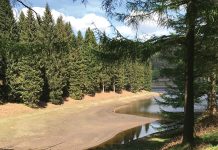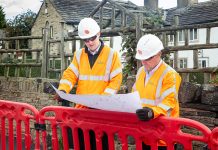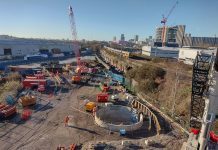Lean thinking, innovation and continuous improvements help Northern Ireland Water surpass targets on its Rural Wastewater Programme and deliver widespread environmental benefits across Northern Ireland.
In 2008 Northern Ireland Water embarked on its ‘Rural Wastewater Investment Programme’ (RWwIP), an initial two-year project aimed at upgrading a series of small wastewater treatment works and septic tanks across rural Northern Ireland. With a budget of £10m, the main objective of the programme was to improve the quality of discharge to local watercourses and bring about significant environmental benefits for rural communities. Although a complex and logistically-challenging contract, NI Water and its contract team – BSG Civil Engineering, Williams Industrial Services and McAdam Design – employed a series of forward – thinking project management techniques and construction innovations to complete a target of 40 sites three months ahead of schedule. With the cost savings made, the team went on to successfully commission a total of 44 sites by the end of March 2010. Now with additional funding granted of £4.3m, the team is looking to instil even more innovations to make further cost savings and complete as many sites as possible for the reduced third-year budget.
Background
Approximately 600,000 people, around one third of Northern Ireland’s total population, live in rural Northern Ireland. Some of the wastewater infrastructure servicing these areas – which pre-dates the establishment of both Northern Ireland Water and its predecessor Water Service – was designed to service only a handful of properties. In many cases the treatment facilities consist of open concrete holding tanks dating back to the 1960s, which over the years have become increasingly ineffective; struggling to cope with the demands of rural population growth and more stringent discharge standards.
The project
The Rural Wastewater Investment Programme represents a package of work being undertaken by Northern Ireland Water to refurbish wastewater treatment facilities in hamlets and villages across Northern Ireland where the population is below 250 people. The aim of the programme is simple – to upgrade as many of the old works as possible, to meet standards set by the Northern Ireland Environment Agency (NIEA), within the budget allocated.
The approach
The NEC Option B project is being undertaken by NI Water in partnership with a consortium of Northern Ireland-based companies – Williams Industrial Services (WIS), BSG Civil Engineering (BSG) and McAdam Design – who have the extensive design, civil engineering, M&E and process expertise along with invaluable local supplier links and the geographical knowledge required to successfully execute the scheme in an efficient, cost-effective manner. A team of experienced local subcontractors work under the main joint venture contractors, BSG and WIS, to cover the whole of Northern Ireland. These key elements of the supply chain bring with them even further local knowledge and enabled the main JV contractors to hit the ground running with construction in November 2008, only four months after award of contract.
Design
In a bid to get the project moving as quickly as possible and maintain significant momentum, NI Water and its Consultants, Belfast-based McAdam Design, stipulated a standardised design for all the wastewater treatment solutions. With support from wastewater treatment specialists Kee Process, the JV put forward a Rotating Biological Contactor (RBC) solution, with units differing only in terms of size to suit the varying populations. All of the new RBCs are designed to allow for a minimum of 10% residential growth in each area. In a bid to determine realistic standards required for such a variety of small works (5 – 250 PE), the NI Water project team meet regularly with the NIEA to discuss the programme of work and examine the watercourses affected by each works. This proactive approach ensures that the design solution for each new works is optimised to obtain the consent standards stipulated by the environmental regulator.
Challenges
The project has not been without its challenges: logistically the WwTWs cover an area of over 13,500 sq km and operationally, the small footprint works must remain fully functional whilst the new equipment is being installed. The latter is by no means an easy task as in many cases the land surrounding the NI Water-owned infrastructure is too small to accommodate the new RBC tanks and supporting equipment. To compound the situation, at many sites there is also insufficient electrical capacity to power the new works and so new 3-phase power supplies are required – both of these issues have the potential to delay construction and commissioning.
Project management
Over 100 sites were initially identified as needing urgent refurbishment work and although each of the sites is relatively small, a tremendous amount of planning, co-ordination and communication is required to undertake the job in the most efficient way possible. In terms of getting projects to site quickly and fulfilling budget spend for Years 1 & 2, the RWwIP team devised a special ‘traffic-light’ system to identify which of the 100 WwTWs posed the least complications.
This involved gathering information on NIEA consent standards, land ownership details, population figures, existing power supplies, access issues etc and determining the most appropriate treatment solution for each site. Once the relevant data is analysed, any ‘good-to-go’ sites are labelled green and passed to the JV to allow them to begin site investigation work. Sites with only minor issues are coloured amber and those with more serious problems are marked red. The team meet every two weeks to discuss progress, address any problems and re-evaluate issues so that amber sites are constantly turning green – ensuring fluidity of work for contractor and guaranteeing contract spend for NI Water. Project management is enhanced by the use of a dedicated project Sharepoint site – a centrally-located information network to which each member of the team has remote access. This acts as an integral information and communications tool onto which every team member uploads relevant data i.e. land ownership maps; design layouts; progress reports; approved drawings; construction programme, electricity connection details; commissioning data, health & safety audits etc. Tasks are recorded after each bi-weekly meeting and are completed/reviewed in the two weeks following.
Land liaison
A crucial part of ensuring that the RWwIP runs to programme is communicating effectively with the many landowners affected by the scheme. In this respect a dedicated project communications manager has been appointed to the scheme. Equipped with detailed site layout maps, the communications manager meets with landowners well in advance of any works taking place to discuss what will be involved and to talk through any problems or concerns they may have. To minimise land purchases – which are expensive and time consuming ¬– the team design the new RBCs to fit within the existing NI Water land ownership where possible. If this isn’t feasible, a land swap will be pursued with the owner, leaving buying land as the last route taken. On some of the schemes completed to date, buying additional land was unfortunately necessary. However, early and sustained communications with landowners has meant that an agreement for early entry for construction to take place (prior to any legal issues being finalised) has been achieved. This has allowed the project to maintain its momentum and most importantly has kept the supply chain working effectively.
Lean thinking and continuous improvements
Throughout the first two years of the RWwIP, NI Water and its contract team have striven to make the design and installation process as efficient as possible. The innovative approach has realised:
• Fully integrated team – client/design/civil/M&E/lands/operational end user
• RBC supplier brought on board as partner to the JV contractors – substantial savings negotiated
• Standardised design developed for all RBC sites
• Just-in-time delivery of RBC units
• Electrical panels and kiosks assembled in specially-developed local construction factory and brought to site as whole units
• In- house design by civil contractor has significantly reduced costs
• Process solutions developed to fit in with existing site footprints where possible to minimise land purchases
• Optimised hydraulic design by contractor to reduce excavation and need for backfilling/ reinstatement
• Combination of desludge manifolds on multiple unit sites to reduce costs
• Simple hose reels installed which are easily transported
• Tankering costs kept to a minimum through successful co-ordination with NI Water Operations
• M&E plant common to all sites thus significantly reducing levels of spares required by NI Water Operations – spares kept locally at WIS stores
• Site layouts with shortest access routes developed to reduce the extent of roads and paved areas
• Reuse of materials on site
• Precast headwall brought to site – eliminates need for concrete pours
• Standardised easy-to-understand handover documentation requiring minimum training for operators – training provided in house by WIS and Kee Process
• Tanker points strategically placed to allow spillages to go back to head of works
• Road layouts produced to allow natural run-off thereby reducing costs on installing site drainage
• Maintenance-free sites with stoned/concrete areas reduces operational costs to NI Water
• Standardised process, standardised layouts, standardised control philosophy and standardised M&E plant used throughout contract
• All training provided by in-house project management team (WIS & Kee)
Greener solutions
At some of the more remote sites, and as an alternative to the RBC solution, NI Water and its project team, working with Rural Generation Ltd, are pursuing the use of willow plantations as competent treatment processes. Three sites are currently being investigated with landowner negotiations at an advanced stage. Although much more lengthy to implement, the willow plantations act as very effective and robust bio-filters, converting the useful nutrients in the wastewater effluent into wood which is then harvested for fuel.
Achievements
With so many factors and unknowns about each particular site to be considered, the Rural Wastewater Investment Programme had the potential to encounter problems from the outset. However by embracing innovation, instilling effective communications and pursuing cost savings at every opportunity, NI Water and its contract team have been able to execute this project in a robust and resourceful manner. This forward-thinking approach has given an excellent foundation to embark on a third year of this strategic upgrade project. Despite the budget being reduced by almost 20%, NI Water and its contract team are confident that their innovative approach and dedication to constantly improve can produce even further excellent results.
Summary of outcomes in years 1 & 2
• Excellent team relationships
• Actual costs are 8.5% lower than asset management predications
• Cost savings have allowed 44 sites to be completed against a target of 40
• High standard of site finishes
• Positive feedback from NI Water end user (Operations)
• Tight NIEA discharge standards being met – in many cases surpassing NIEA expectations
• Outstanding Health & Safety records
• Extensive environmental benefits for local communities – reduced odours, flooding etc
• 44 watercourses significantly improved
• Widespread favourable feedback from landowners
• Meeting a challenging programme of work whilst delivering excellent value for money
• Secured £4.3m budget to undertake work for a third year





